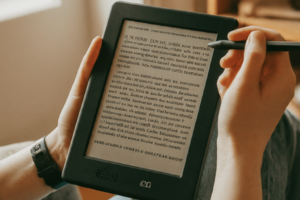In the world of display tech E Ink and e-paper get thrown around and many are wondering what the difference is and where they are used. Both have their advantages, especially for reading and information display but they serve different needs. Let’s dig in what is e ink vs epaper, how it works, and where it beats other tech.
Table of Contents
*****Disclosure: This post may contain affiliate links, which means we may receive a commission, at no extra cost to you, if you make a purchase through a link.****
What is Electronic Paper?
Electronic paper or e-paper is a display technology that mimics the look of ink on paper. This innovation gives a paper like reading experience that is both beautiful and functional. Unlike traditional displays that emit light e-paper reflects ambient light so it has high contrast and glare free view. This is more comfortable for long use especially in e-readers where long reading sessions are common.
It works even in direct sunlight, unlike LCD screens that struggle to be visible under bright conditions. Essentially electronic paper displays are made up of millions of tiny capsules filled with a clear fluid containing tiny particles, each as wide as a human hair. By applying an electric field these particles (white positively charged and black negatively charged) are manipulated to display text and images and a static image that remains visible even without power.
What is E Ink Technology?
E Ink technology is a specific type of electronic paper display that employs a two-pigment electronic ink system. Known for its low power consumption, no glare, and eye-friendly properties, E Ink is commonly used in e-readers. The system functions similarly to traditional ink technology but utilizes microcapsules that enable the display to switch between colors.
Characteristics of E Ink vs EPaper
E Ink and EPaper are revolutionary display technologies that closely mimic the appearance of traditional ink on paper. Designed to provide a reading experience akin to that of a physical book, these displays offer several key characteristics that set them apart from other technologies.
One of the standout features of E Ink and EPaper displays is their reflective nature. Unlike conventional screens that emit light, these displays reflect ambient light, making them much more comfortable to read. This reflective quality also provides a wider viewing angle, ensuring that text and images remain clear from various perspectives.
Another significant advantage is their low power consumption. E Ink and EPaper displays are incredibly energy-efficient, consuming minimal power to maintain a static image. This makes them ideal for devices that require long battery life, such as e-readers and electronic shelf labels.
The high contrast ratio of these displays ensures that text and images appear crisp and clear, even in bright environments. Additionally, the absence of glare makes them easy to read in direct sunlight, further enhancing their usability in various lighting conditions.
Overall, the combination of ambient light reflection, low power consumption, high contrast, and no glare makes E Ink and EPaper displays a superior choice for a comfortable and sustainable reading experience.
Key Differences and Advantages
One of the key differences between electronic paper and other display technologies like LCD and OLED is that e-paper displays reflect ambient light rather than emitting their own. This reflection allows for a more natural reading experience, akin to reading paper books. Users benefit from reduced eye strain and fatigue, making e-paper an ideal choice for extended reading sessions.
However, E Ink displays come with a slower refresh rate, taking a moment to render text and images. This deliberate pace can actually foster a more focused reading experience, minimizing the compulsive behavior associated with fast-paced digital interactions common on traditional displays.
Another advantage of electronic paper displays is their limited functionality, often designed for basic tasks like reading, note-taking, and viewing images. This simplicity is appealing to those seeking a distraction-free digital environment, contrasting with the myriad notifications and features available on smartphones and tablets.
Technical Differences
E Ink and EPaper displays stand out from other display technologies due to their unique technical characteristics. At the heart of these displays is a sophisticated technology involving tiny microcapsules filled with positively charged white particles and negatively charged black particles suspended in a clear fluid. By applying an electric field, these particles are manipulated to form text and images, creating a static image that remains visible without continuous power.
One notable difference is the refresh rate. E Ink and EPaper displays have a slower refresh rate compared to LCD screens and OLED displays. This means it takes a second or two to fully render text and images. While this might seem like a drawback, it actually promotes a more focused and deliberate reading experience, free from the distractions of fast-paced digital interactions.
Additionally, E Ink and EPaper displays are designed for specific applications, such as e-readers and digital signage. They are not intended for complex graphics or video playback, which makes them less versatile but highly effective for their intended purposes. This limited functionality ensures that these displays excel in providing clear, readable content without unnecessary distractions.
In summary, the unique display technology, slower refresh rate, and application-specific design of E Ink and EPaper displays make them distinct from other display technologies, offering a specialized solution for reading and information display.
Elevate Your Reading Experience with Kindle’s E Ink Technology
So what’s the best device for reading? Look no further than the Kindle Scribe. It uses E Ink technology to give you the best reading experience. The Scribe’s paper like display mimics real paper so you can read for hours without the glare and eye strain of screens. It reflects ambient light so you can read in bright sunlight whether you’re at the beach or in your backyard. Low power consumption means one charge will last weeks so you can get lost in your favorite books without the hassle of recharging. Try the future of reading with the Kindle Scribe where innovation meets convenience for book lovers.

Applications of Electronic Paper Displays
Electronic paper displays are versatile and can be employed in various contexts, including digital signage, electronic shelf labels (ESL), and even outdoor traffic signs. Their ability to remain legible in both bright and dim lighting conditions makes them ideal for public spaces where clear visibility is crucial.
For instance, electronic shelf labels in retail can display product prices and information that can be updated wirelessly, streamlining the price adjustment process while providing customers with accurate data. This low power usage allows ESLs to operate efficiently for extended periods without frequent battery changes.
In public transportation, e-paper displays can convey real-time updates on schedules and service alerts, offering a sustainable and reliable solution for passengers. Their durability and weather resistance make them particularly suited for outdoor environments.
How Electronic Paper Displays Work
The mechanics of electronic paper technology are fascinating. Tiny microcapsules filled with clear fluid contain particles that respond to an electric field. By applying electric charges to electrodes above and below the capsules, the position of the particles can be controlled, allowing the display to present various colors and images. This process is efficient, consuming minimal power to maintain a static image, which is why E Ink and other e-paper displays are celebrated for their low power consumption.
The ability of e-paper to retain an image without constant electricity is a significant benefit, ensuring that important information remains visible even during power outages. This feature makes electronic paper displays especially advantageous for digital signage and electronic shelf labels where continuous visibility is paramount.
Benefits of Using Electronic Paper Displays
One of the most notable benefits of e-paper displays is their energy efficiency. They can display content without needing constant refreshing, making them particularly suited for devices like e-readers. This low power consumption translates into extended battery life, which is a major consideration for portable devices.
Additionally, e-paper displays reduce the emission of blue light, which can disrupt sleep patterns and contribute to digital eye strain. By reflecting ambient light instead of emitting its own, e-paper provides a comfortable reading experience that is easier on the eyes, even during extended periods of use.
The bistable nature of electronic paper allows it to hold images without power, which is not only convenient but also environmentally friendly. For businesses and consumers aiming to reduce their carbon footprint, this sustainability aspect of e-paper displays is a significant advantage.
Environmental Benefits
E Ink and EPaper displays offer several environmental benefits that make them an eco-friendly choice in the world of display technology. One of the most significant advantages is their energy efficiency. These displays consume very little power, which not only extends the battery life of devices but also reduces the overall carbon footprint. This energy efficiency is particularly beneficial for devices like e-readers and electronic shelf labels, which need to operate for extended periods without frequent recharging.
Another environmental benefit is the reduction of e-waste. E Ink and EPaper displays are designed to be long-lasting and durable, minimizing the need for frequent replacements. This durability helps reduce the amount of electronic waste generated, contributing to a more sustainable environment.
Moreover, E Ink and EPaper displays are made from sustainable materials, such as plastic and metal, which can be recycled and reused. This focus on sustainability ensures that these displays have a lower environmental impact throughout their lifecycle.
In conclusion, the energy efficiency, durability, and use of sustainable materials make E Ink and EPaper displays an environmentally friendly choice, aligning with the growing demand for sustainable technology solutions.
Future Developments
The future of E Ink and EPaper displays is bright, with continuous advancements and innovations on the horizon. Researchers are actively working on improving the display technology, focusing on areas such as color gamut and refresh rate. These improvements aim to enhance the visual quality and responsiveness of E Ink and EPaper displays, making them even more versatile and appealing.
New applications for E Ink and EPaper displays are also being explored. For instance, smart packaging and wearable technology are emerging as exciting new frontiers. These applications leverage the unique properties of E Ink and EPaper displays, such as low power consumption and high visibility, to create innovative and practical solutions.
Additionally, there is a growing trend towards integrating E Ink and EPaper displays with other technologies. Combining these displays with touchscreens and sensors opens up new possibilities for interactive and multifunctional devices. This integration can lead to the development of cutting-edge products that offer a seamless blend of functionality and user experience.
In summary, the ongoing improvements in display technology, exploration of new applications, and integration with other technologies ensure that E Ink and EPaper displays will continue to evolve and play a significant role in the future of display technology.
Choosing the Right Electronic Paper Display
When deciding between E Ink and other display technologies, consider the specific application. E-readers benefit from the paper-like reading experience and low power consumption of e-paper. Digital signage, on the other hand, might prioritize displays that are visible in varying lighting conditions and require low power for sustainability.
Evaluate the functionality needed as well. If your application demands advanced features like internet browsing or multimedia capabilities, you may need to explore hybrid solutions that integrate e-paper with other technologies.
Conclusion
In today’s digital age, electronic paper displays stand out for their unique benefits, including energy efficiency, eye comfort, and bistability. Whether for e-readers, digital signage, or electronic shelf labels, e-paper technology offers a compelling alternative to traditional display methods. By understanding the distinctions between E Ink and other technologies, you can make informed decisions that align with your specific needs and user expectations.
As the demand for sustainable and user-friendly display solutions grows, electronic paper displays continue to evolve, offering innovative applications across diverse industries. Whether in retail, transportation, or education, e-paper technology is proving to be a vital component in enhancing user experience and operational efficiency.



